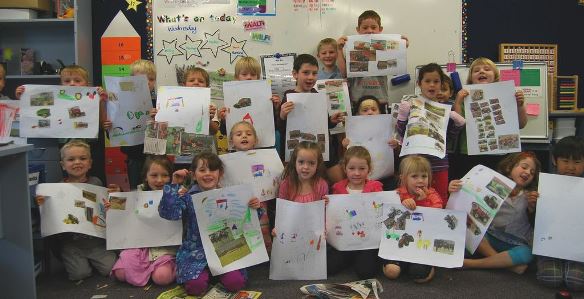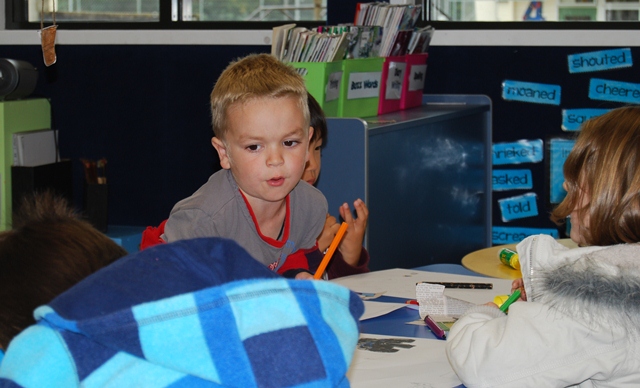Gordonton School kids ready for Fieldays
Room nine at Gordonton school prepares for Fieldays with some drawings of what the huge agricultural event means to them.
Fused between clear plastic laminate, A to Z letters drawn on white cards sit above wall-length windows. Twenty-one orange, brown, and yellow cutouts, possibly lions, look down on activities.

A length of string drawn the classroom width displays pegged artworks, hung to a height prejudicial to all but under six-year-olds. Pegs secure hot air balloons crafted from paper and string with dangling paper baskets; multiple versions of sunflowers in orange, yellow and green; and self-portraits with descriptive texts in cloud-shaped white bubbles read, ‘Ko Ben ahau’, ‘Ko John ahau’, and ‘Ko Meg ahau’.
The pregnant Mrs Sam Sunde, Gordonton Primary School’s Room Nine teacher, sits low on a chair in front of her 21 crossed-legged pupils sitting on the mat. “I thought this morning we would draw a picture of all the things we might see at the Fieldays,” Mrs Sunde says. Her loose fitting emerald green blouse barely hides her baby bump. Her unborn child gets a front row seat and head start in the schooling system. Her pupils sit further back making indistinguishable chatter, their voices sound the same: soft and high and innocent. Mrs Sunde raises her right arm, touches the side of her left pointer finger to her lips and patiently encourages quiet. The children copy her pose and the room falls silent.
“Has anyone been to the Fieldays?” asks Mrs Sunde. Three of the 21 children raise their arms. “What sorts of things might you see at the Fieldays?”
“Tractors and trailers,” says Kaden.
Ben says “Ploughs.” His voice is soft yet matter-of-fact.
“Gumboot shop,” suggests Danelle. The room experiences rare silence. Danelle clarifies louder:
“Where the gumboots are.”
“Now,” Mrs Sunde asks, “Why are we going to see tractors, and gumboots, and things like that?”
The kids shuffle on the mat.

Gordonton Primary School, a rural school of 260 pupils, sits on bumpy countryside just over a oneway bridge on a back road, off another back road from Hamilton to Auckland, in the village of Gordonton.
“At the Fieldays you can see all kinds of things,” Mrs Sunde explains. “What sorts of people go to the Fieldays?”
Nathan raises his hand. “Farmers?”
The class erupts with contributions. They talk over each other.
“My dad is a farmer.”
“My brother is a farmer.”
“I like the farm.”
She shushes the class and they copy her ‘quiet’ pose each good student looking around to catch the last classmate to be silent.
The boys wear t-shirts with pictures of machines and their heroes: ‘Fighter jets. Not Guilty Squadron’ – a red and blue fighter jet shoots across the grey t-shirt sky. ‘Honda Classic Annual Custom Bike Interstate’ – a gleaming metal machine accompanies the text. The Batman symbol sits in its yellow oval badge on a black t-shirt. Two monster trucks with fat wheels and exposed shocks war with each other over a six-year-old’s t-shirt.
“Most of the children at this school live on farms,” says Mrs Sunde. “Just three or four come from the city. Hamilton.” She looks at the little farmers. “This was where I went to school.”
The girls wear multiple combinations of pink and purple: a purple top with light pink, dark pink, and blue horizontal stripes. Pink tights with small purple hearts and pink socks. A pink fleece. A pink dress. Pink gloves. Purple jeans. Pink hair tie.
“I want you to tell a buddy what you might put in your picture of the Fieldays.” Kids turn to each other and, after spirited discussions, Mrs Sunde asks the children what they will draw.
Elle is going to draw cows.
Taylor: “Cows and sheeps.”
Ben: “Tractors and trailers.”
Nathan: “Food.”
Ava: “A tractor.” She asks if she can bring her dog to school. The answer is no. So she asks if she can bring her cat. The answer is also no.
Alastair: “Food.”
Danelle is committed to the Gumboot Shop.
Mrs Sunde hands out sheets of paper and the children return to their tables. They set to work.

The classroom walls shout learning in colour. It is the visual equivalent to too much sugar. Above the white board cut-out coloured letters spell MATHS, the subject seems exciting with its blue A, yellow T, Green H, and red S. The shelves are green and blue and store colourful blocks, folders, containers, and books.
“Room nine, I’ve just found some newspapers that have some farming pictures. If you see a cool picture you can cut it out and stick it on.” Mrs Sunde places publications on the mat at the front of the classroom. Chairs fall backwards, children bump into each other, and pencils roll off tables. The kids rush to the front of the classroom. A group of three blond boys lean over an opened newspaper, Alastair, Samuel, and Nathan. Nathan, the leader, identifies their task: “We are trying to find a fence.” But all the pictures are motorbikes and tractors. Samuel points to a very distant fence in the background in a photo of a tractor: “There’s an awesome one.”
The blue table must be where the class’ business minds gravitate. At Jessica’s Fieldays, her family visits a shop. “They are going to buy some gumboots at the shop,” Jessica says. She has gumboots, “Rainbow Dash ones.” She points to another shop, “And a food shop, you can buy cakes.” She goes on to explain that burgers are available.
Danelle has drawn cows, “The flower one is a girl, and also the second one is a boy. There is food. Like burgers and stuff and pies. Because I go to work with my dad and mum always buys pies to have.” She colours a cow purple, “I also like sausage rolls. The gumboots are $5. Um, the tractors are,” she decides, “$9.”
Kyla has coloured all the animals red, “It’s a Sheep and it’s $5.” A red cow is $10 and gumboots are, “Just like… $5.” Maybe she considered the popularity of red gumboots because she makes a price adjustment, “Actually $3.”
Is the dog for sale?
“No,” Kyla says. “But the tractor is $1. Grapes and pita breads are $2.”
It is a beautiful summer day at Zoe’s Fieldays, “That’s me, my mum, nana, Aunty Lizzy. That is my granddad. That’s a cow and sheep.” She explains that her family has just one tractor. It’s red. “And my dad is going to buy a blue one. We only have black cows and our neighbours have those cows and those cows.” She points to a picture of a brown and a black and white cow. Has she been to the Fieldays? “Only two times.” She is six-years-old.
The word WRITING is spelt across the front wall, the black letters are hand-drawn with coloured outlines. PUBLISHING sits further along, a hanging star in the publishing sections asks: ‘Does it make sense?’ A poster lists the stages of writing: 1. Drafting, 2. Revision, 3. Proof Reading, 4. Editing, 5. Publication.
Alastair has drawn tractors and glued tractor pictures to his Fieldays. He points and names each machine, “John Deer, Case.” Case is his favourite kind. He considers its virtues, “They are strong.” He can drive a John Deer but not a Case, “Because they have hard things. They are very hard to push and pedals.”
Is this a Case?
“No it’s a McCormick. It is trying to carry a chopper, but it can’t.”
What’s a chopper?
“The chopper does the maize.”
Is that a chopper?
“No, it’s a combine.”
They do the same thing? Don’t they?
“No, that one chops maize and this one chops grain.”
A combine does the grain.
He points to the tractors on his page, “John Deer, John Deer, that’s a different kind of John Deer,
Case, Case, McCormick, Chopper.”
What do you want to be when you grow up?
“I am going to drive a maize chopper.”
Gordonton Primary School’s Room Nine have worked hard. The state of the room is proof. Papers are destroyed by snips. Glue sticks lay abandoned, caps lost. Coloured pencils lie on the floor. Mrs Sunde ends the activity: “It is play time now. We will clean this mess up after the break.”
The orange, brown, and yellow lions watch as the children pass beneath them out the door. Squeals, joy, the children disappear outside until the next classroom activity, one they will approach with wonder, blissfully unaware of its pleasurable newness. Everything is wonderful when you are five years old, especially the Fieldays.




